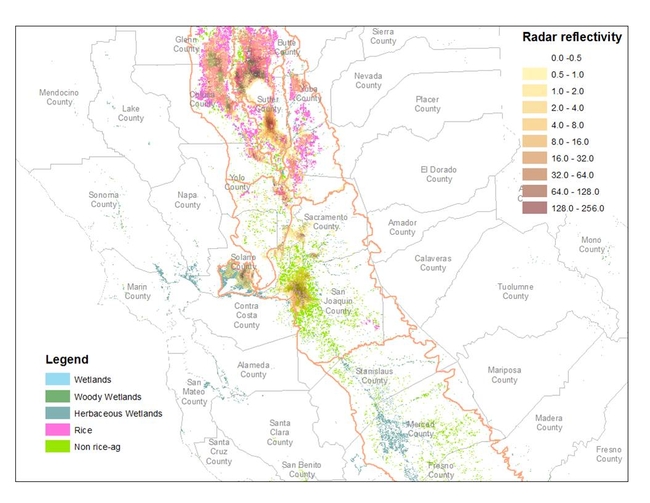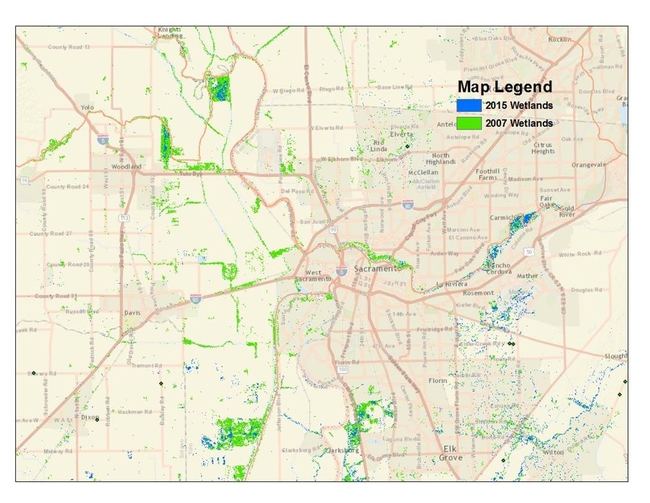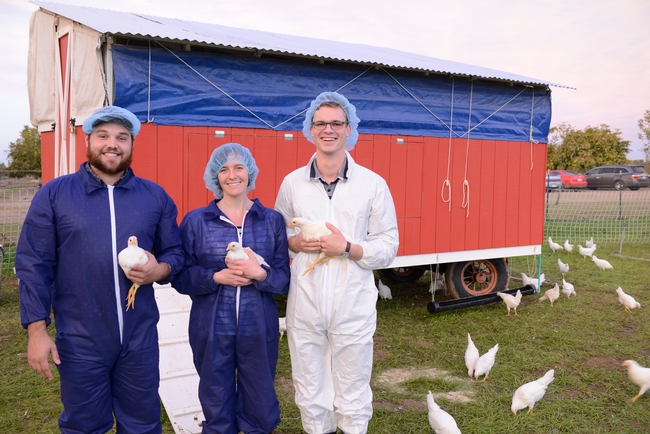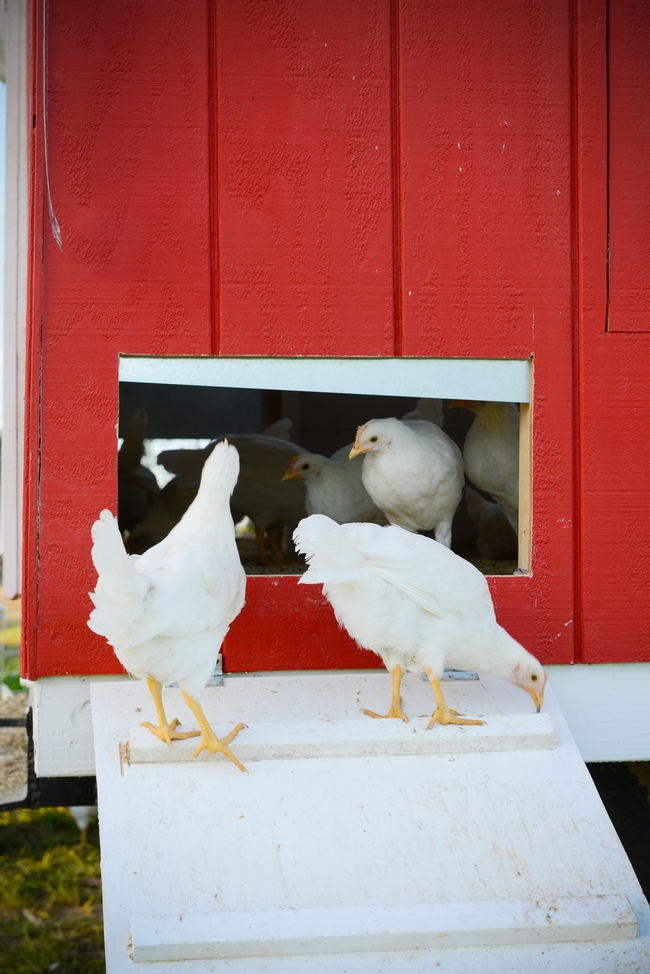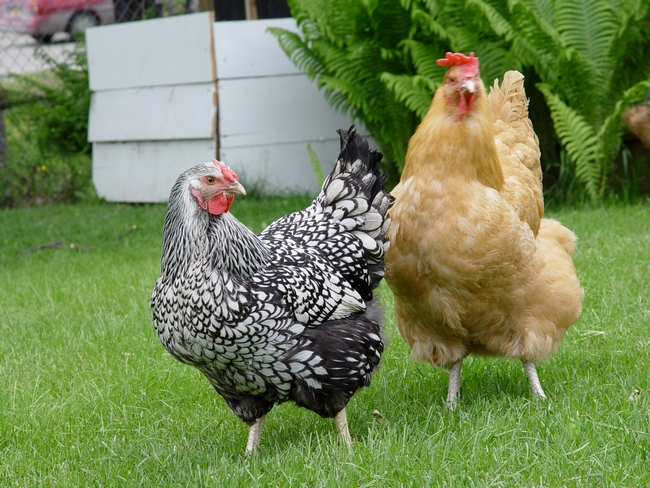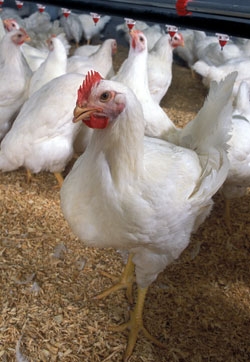Posts Tagged: Poultry
Weather radar helps researchers track bird flu
The same weather radar technology used to predict rain is now giving UC researchers the ability to track wild birds that could carry the avian influenza virus. Avian influenza, which kills chickens, turkeys and other birds, can take a significant economic toll on the poultry industry. In 2014- 2015, the United States experienced its worst bird flu outbreak in history, resulting in more than 48 million birds dying in 15 states, including California.
“We use the existing network of weather radar stations in the U.S. in the same way that radar is used to track rain, except that we process the data to allow us to interpret the radar signal bouncing off birds instead of raindrops,” said Maurice Pitesky, UC Cooperative Extension poultry specialist. “The data can be interpreted to track birds.”
NEXRAD, or next-generation radar, is a network of 160 high-resolution S-band Doppler weather radars operated by the National Weather Service. The technology works best for tracking birds in the winter during feeding. When waterfowl leave their roosting locations in concert to feed, their bodies produce reflectivity of the radar beam.
“By tracking mass bird movements remotely in real-time, we hope to gain novel strategic insights with respect to surveillance and prevention of avian influenza transmission to domestic poultry,” said Todd Kelman, a veterinarian and engineer who co-leads the project with Pitesky, who is also in the School of Veterinary Medicine at UC Davis. They are exploring how the information might be used to prevent an outbreak.
In California, waterfowl migrate by the millions from September through March via the Pacific Flyway, where they winter in wetlands, rice and corn fields. The Central Valley alone is home to 3 million waterfowl at the height of migration.
“Using NEXRAD and various other approaches, we hope to be able to produce monthly or quarterly maps that will alert poultry producers as to the locations of waterfowl in the Central Valley of California,” Pitesky said.
“Waterfowl populations can have different habitat based on the amount of precipitation in a given year,” said Pitesky. “Therefore, we need to use these types of monitoring tools to understand where waterfowl are located. Landsat, or satellite-based land imagery, and NEXRAD are two remote tools that may be very useful, as opposed to flyovers and banding, which are more expensive and not practical for large geographical areas.”
The project — funded by UC Agriculture and Natural Resources — is a collaboration between UC Davis School of Veterinary Medicine and Jeff Buler, University of Delaware wildlife ecologist whose team first developed the NEXRAD approach in the Central Valley of California. They are also working with the U.S. Geological Survey, the California Department of Food and Agriculture, the California Poultry Federation, the Pacific Egg and Poultry Association and Point Blue, an organization that focuses on conservation science.
Pastured poultry farm to foster innovation for small chicken farms
UC Agriculture and Natural Resources (UC ANR) provided seed money to launch a new Pastured Poultry Farm at UC Davis. The farm is home to 150 young chickens and a living laboratory where students and faculty researchers hope to develop innovative solutions benefiting pasture-based farms, integrative crop-and-poultry farms and backyard flocks.
Pasture-based chicken production offers many benefits as well as some challenges in terms of food safety, animal health and welfare, and environmental impacts, said Maurice Pitesky, UC ANR Cooperative Extension poultry specialist with the School of Veterinary Medicine and co-leader of the poultry project.
The new 4.5-acre farm, located about one mile west of the central UC Davis campus, includes a seeded, irrigated pasture, where the chickens can forage. In the center is a bright red student-built Eggmobile for night time housing. The ‘coop on wheels' can be strategically moved around the land for consistent fertilization. The pasture uses a portable electronic fence to protect against predators and is surrounded by a 50-foot band of uncultivated land to serve as a wildlife buffer.
“This is a unique innovation, research and outreach resource for the Western United States,” Pitesky said. “The project includes faculty and students with expertise in veterinary medicine, husbandry, welfare, pasture management and engineering, which allows us to address issues related to predator control, welfare, food safety and food efficiency.”
Debbie Niemeier, professor in the Department of Civil and Environmental Engineering, and her team have already developed a number of innovations for the project, including a tarp-pulley system, portable-shade and predator-mitigation structures, an automatic watering system, and modular roll-out nest boxes.
One of the advantages of the pasture-based system is the opportunity for a farmer to integrate chicken production with a farm's existing cropping system, with the chickens providing natural fertilizer for the crops.
“It's also a way for crop farmers to move into poultry production without expanding their land or adding nitrogen fertilizer to their farming system,” Pitesky said.
The new project is largely driven by students - drawn from the School of Veterinary Medicine, College of Engineering, and College of Agricultural and Environmental Sciences - who designed and constructed the Eggmobile. The mobile barn includes 32 nest boxes, each capable of accommodating several chickens. As it is moved to different locations in the pasture, chicken droppings gradually fertilize the grass. The student and faculty research teams will be delving into issues involving diseases and chicken health, predation by wildlife, and occupational health for workers.
Eggs produced by the project's flock will initially be donated to food shelters. The potential for eventual egg sales to the community is being explored. Eventually, the research team hopes to construct multiple Eggmobiles with different designs, and in time would like to expand the project to include broiler chickens, as well as cropping systems that integrate poultry, in order to fully maximize the potential of the land for food production.
A list of donors and other information about the UC Davis Pastured Poultry Farm can be found online. The School of Veterinary Medicine has established an online site where individuals interesting in supporting the UC Davis Pastured Poultry Farm financially can make donations.
Author: Patricia Bailey
Reduce the risk of bird flu in backyard chickens
Protecting their birds against disease should be a priority for chicken owners, no matter what size the flock, according to Maurice Pitesky, a UC Agriculture and Natural Resources Cooperative Extension specialist in the School of Veterinary Medicine at UC Davis.
“Wild birds are the biggest risk because they can carry the virus but look completely healthy, so it's important to keep them away from your chickens,” said Pitesky. He adds that signs your chicken could have contracted avian influenza are depression, no appetite, diarrhea, soft/misshaped eggs, and sudden and increased or unexplained death in flocks.
Commonly called “bird flu,” the avian influenza virus - routinely found in wild waterfowl - can spread to chickens and other domestic poultry and cause significant mortality and economic loss. This year the nation has experienced the worst bird flu outbreak in history, with three confirmed cases in California — two of which carried the more dangerous, highly pathogenic strain. In each case, the disease, which is not dangerous to humans, was introduced by wild waterfowl migrating along the Pacific Flyway. Some of these wild birds might now be carrying the Eurasian strain of the H5 highly pathogenic avian influenza.
Pitesky and the California Department of Food and Agriculture offer some important bioscurity tips to help reduce the risk of your chickens contracting bird flu:
- Wash your hands with soap and water or use hand sanitizer before and after working with chickens.
- Use footbaths before entering and exiting the fenced-off coop area. Each footbath — a covered container with an approved disinfectant to disinfect shoes — should be placed in a staging station, such as on a concrete surface or a pallet, to prevent dirt from being tracked into the footbath. Disinfectant should be changed daily to be effective.
- Have designated “coop boots.” These will be the only shoes that go into your chicken area, and they won't go anywhere else. If you hunt waterfowl, make sure your equipment and clothing are separate from your domestic poultry.
- Don't allow wild animals and waterfowl to come in contact with your chickens. For example, if you have a pond or body of water that can attract waterfowl to or near your facility, consider draining if feasible.
- When obtaining birds, isolate them from other birds for 30 days before adding them into your flock. This will reduce the risk of introducing disease into the original flock.
- Always obtain birds from reputable, disease-free sources that practice good biosecurity methods, and purchase feed from clean, dependable suppliers. Store the feed in containers that are bird, rodent, and insect proof. Provide clean, fresh water to your birds at all times.
- Restrict access by visitors onto the premises where your birds are housed. Do not allow people who own other birds to come in contact with your birds.
- Report signs of illness or increased mortality to your veterinarian or the Sick Bird Hotline 866-922-BIRD (2473). In addition, necropsies are provided free-of-charge for owners of less than 1,000 chickens at the school's California Animal Health and Food Safety Laboratory System.
By joining the California Poultry Census, you can receive the latest information and updates about avian influenza in California.
Early disease detection, prevention key to limiting spread of disease
State officials credit early disease detection and prevention, through proactive surveillance and good biosecurity practices, as key factors limiting the spread of avian influenza. For example, a wildlife surveillance program conducted by USDA Wildlife Services regularly submits samples to the veterinary school's California Animal Health and Food Safety Laboratory System at UC Davis for testing. This helps scientists and animal health officials understand where certain viruses are circulating in the U.S., including the more dangerous strains for domestic poultry.
UC poultry experts are conducting a statewide survey of backyard chickens, and providing outreach and training on health and disease prevention to individuals who, in turn, will provide the information to backyard chicken producers and small, commercial chicken operations. In addition, veterinary researchers Rodrigo Gallardo and Beate Crossley have recently been awarded a grant to study new, highly pathogenic viruses affecting the U.S. poultry industry. The goal is to better understand why these viruses have been so difficult to eradicate and to help prevent their introduction to commercial farms.
Additional information:
- University of California Cooperative Extension Poultry Resources
- CDFA Backyard Biosecurity for Poultry
- USDA Backyard Biosecurity
The price of chicken feed is rising
Soaring feed costs are forcing San Joaquin Valley poultry producers to cut costs, raise prices - and, in some cases, close their doors, reported Robert Rodriguez in the Fresno Bee this weekend. Feed prices have climbed as much as 50 percent since last year, fueled by the increasing demand for corn.
Director of the UC Agricultural Issues Center Daniel Sumner told the reporter that rising costs for poultry producers will boost the retail price, unless something else acts to keep prices down.
"So, bottom line," Sumner said, "we should see higher retail prices with these high grain and oilseed prices."
Ranchers beef over obstacles to local meat
Carlos Alcalá, Sacramento Bee
Small ranchers in El Dorado County gathered at a Local Meat Summit in Placerville last week to discuss obstacles to selling their products locally. Meat must be harvested at a USDA-approved facility, and there aren't many of those.
Program representative Sean Kriletich of UC Cooperative Extension in Amador and Calaveras counties is working with ranchers to solve the problem.
"We're trying to work toward getting a USDA-inspected facility for our region," Kriletich said.
If more small ranchers can find a way to sell grass-fed beef locally, it will do more than benefit the farmers, Kriletich said. It will preserve open space for the entire community.
"If people want to keep more land in agriculture, we have to get more money to the producers," said Kriletich, who said he used to run cattle himself, where El Dorado Hills subdivisions now sit.
Beekeepers asking Humboldt cities to loosen regulations on residential hives
Grant Scott-Goforth, The Willits News
A recent change in attitudes toward urban sustainability and education about bee culture spurred the Humboldt County Beekeepers Association to ask the cities of Arcata and Eureka to loosen restrictions on residential beekeeping.
UC Cooperative Extension farm advisor Deborah Giraud said the risks of keeping bees in residential areas are minimal. ”In general, it's really important to have more honeybees,” Giraud said. “We have a lot of problems with pollination here because of weather. Most calls in here are about fruit trees. And it's a pollination problem.”
Animal agriculture in the spotlight
The Los Angeles Times today ran a story about hidden-camera video footage of a Turlock poultry farm. The story was picked up by the Associated Press and has now appeared in at least 40 newspaper and broadcast media outlets.
According to the Times story, the video was shot by an undercover investigator with the group Mercy for Animals and shows workers mistreating chickens at Gemperle Enterprises.
"What I saw on that video is not what our company does," owner Steve Gemperle was quoted in the article. "We do not accept any abuse of farm animals. It's against our values and morals."
According to the story, UC Davis emeritus professor of veterinary medicine, Ned Buyukmihci, was quoted in a letter the executive director of Mercy for Animals, Nathan Runkle, sent to Merced and Stanislaus county district attorneys.
The letter quoted Buyukmihci as saying the treatment was "cruel by any normal definition of the word" and violated the "norms of conduct with respect to animal welfare and veterinary care," according to the Times article.
The Times story, written by reporter Eric Bailey, includes a link to the Mercy for Animals Web site, where the 7-minute video documentary may be viewed online. The video, which ends with a plug for vegan eating, comes six months before California voters consider the California Prevention of Farm Animal Cruelty Act, which is on the November ballot
Jim Downing wrote a story about the Mercy for Animals video for the Sacramento Bee. Associated Press Fresno bureau chief Garance Burke posted the AP story, which has appeared in the San Diego Union Tribune and the San Francisco Chronicle. TV reports have appeared on the CBS affiliate in Fresno and the ABC affiliate in the Bay Area.


